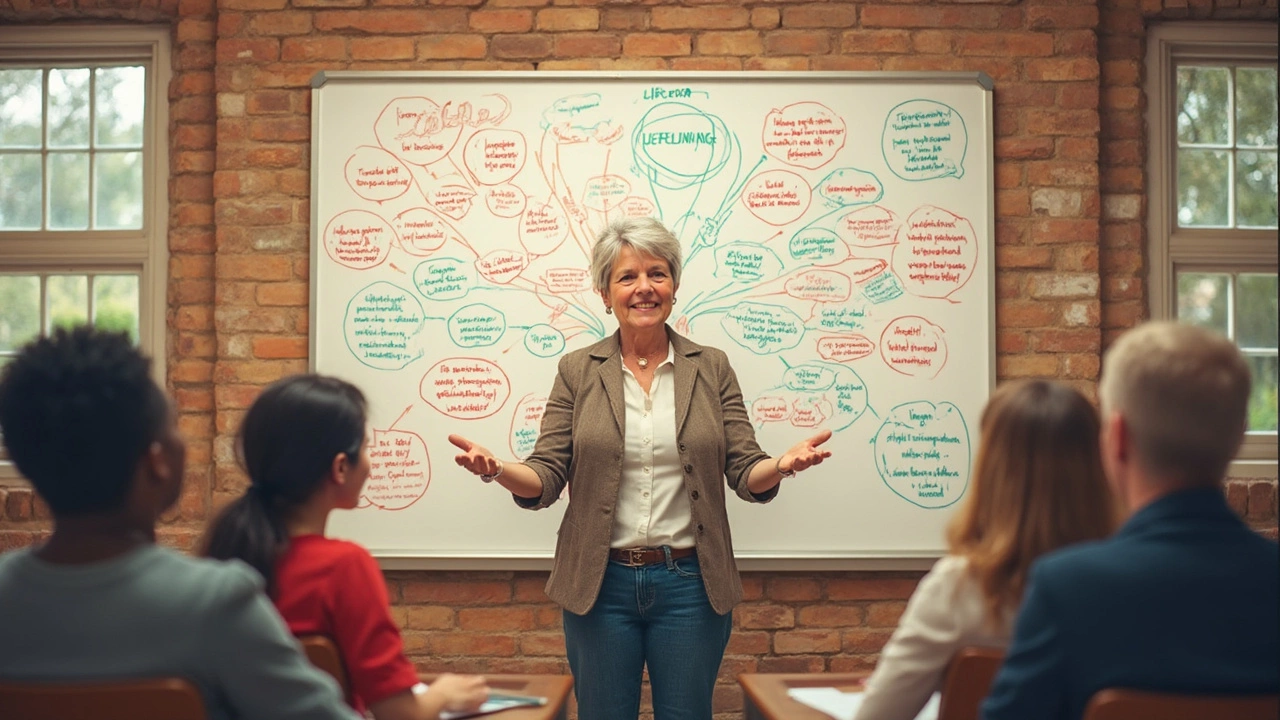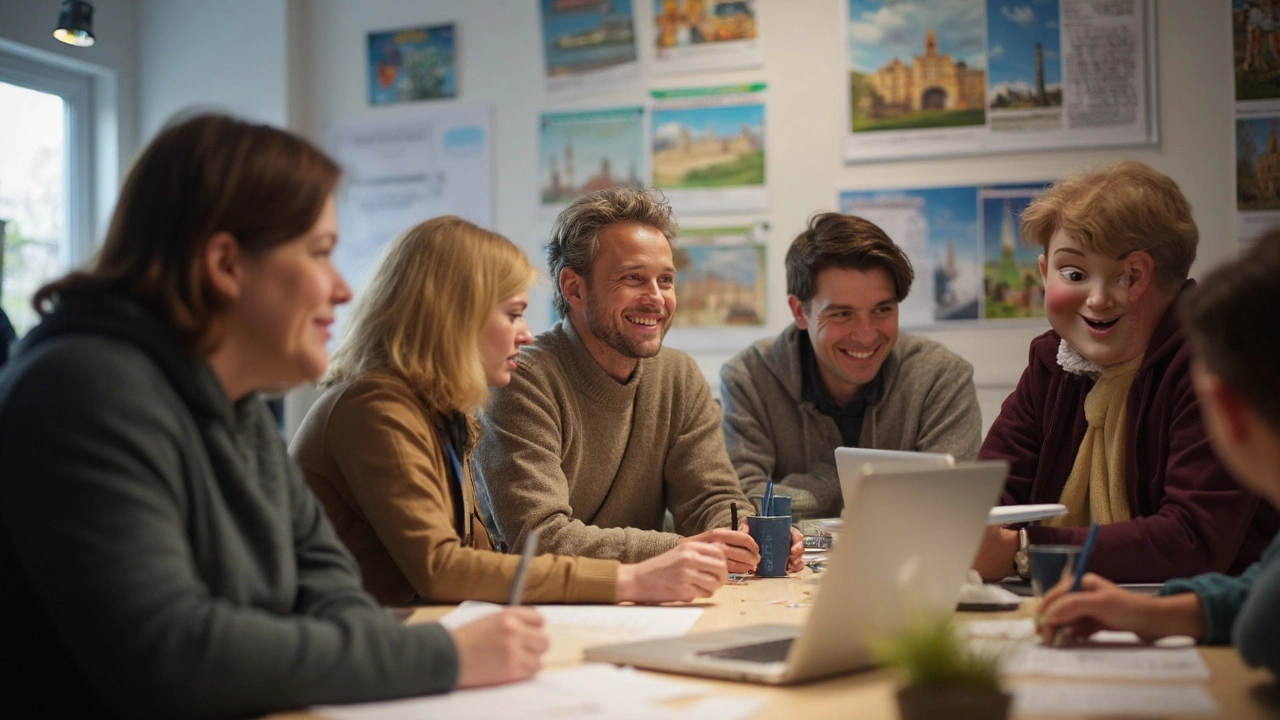Forget everything you remember from sitting in stuffy classrooms as a kid—adult education is built around totally different ideas. The biggest shift? Adults like to know *why* they're learning something, not just memorize facts because someone told them to. That’s where the main concepts in adult education come in. They help teachers and learners get results without the boredom or frustration.
If you’ve ever taken a night class, joined a work training, or tried to pick up a hobby as a grown-up, you’ve seen these ideas in action—sometimes without realizing it. Understanding these concepts makes learning as an adult easier and more enjoyable, whether you’re after a career change or figuring out your garden.
Ready to break down what actually works in adult education? Let’s get practical and see why these theories are everywhere—from community college courses to online tutorials and corporate workshops.
- Andragogy: How Adults Actually Learn
- Experiential Learning: Learning by Doing
- Transformative Learning: Changing How We See the World
- Self-Directed Learning: Taking Charge
- Tips for Putting These Concepts to Work
Andragogy: How Adults Actually Learn
When it comes to adult education, the buzzword you’ll hear a lot is “andragogy.” Think of it as the opposite of what most kids go through at school (which is called pedagogy). Malcolm Knowles, a big name in this area, described andragogy as the art and science of helping adults learn. It’s not just a fancy term—this concept changes everything about how lessons are planned, taught, and even how adults think about learning itself.
"Adults are motivated to learn as they experience needs and interests that learning will satisfy." – Malcolm Knowles, 1973
What’s so different about adults? First, they bring a ton of real-life experience, which is like having a built-in library of knowledge. Lessons that connect to these experiences tend to stick better. Adults also focus on learning things that make a real difference for them—on the job, at home, or in their relationships. They want to problem-solve, not just pass tests.
Here’s what makes andragogy work in practice:
- Purpose-driven learning: Adults care about the “why.” If the lesson solves a real problem or supports a goal, engagement shoots up.
- Experience matters: Activities are more hands-on, because adults want to use what they already know. Discussion and sharing stories aren’t side notes—they’re key parts of most adult learning sessions.
- Self-direction: Adults like to steer their own learning. They set goals, ask questions, and jump into projects that mean something to them.
- Relevance: Topics that match up with everyday life or job needs make learning stickier and more rewarding.
Want some numbers? A 2023 survey by the Adult Learning Research Institute found that 67% of adult learners said they’d drop out of a course if it wasn’t clearly tied to their own goals. That’s why smart teachers start with “why this matters to you” and design activities that fit into real-life situations.
If you’re planning a class or workshop for grown-ups, or just trying to learn something new yourself, keeping andragogy in mind can make everything flow better. Focus on practical challenges, let learners steer the conversation, and ground lessons in real-world problems, and you’ll see results fast.
Experiential Learning: Learning by Doing
Everyone’s heard that phrase, “You learn by doing.” That’s the heart of experiential learning. Instead of just listening to a lecture or reading a manual, you actually try things out. It’s a real game-changer in adult education and pops up all over—from on-the-job training to volunteering and role plays.
The famous educational psychologist David Kolb built his whole theory around this. He said adults cycle through a process: first, you get hands-on and do something; next, you think about what happened; then you make sense of it; and finally, you try again, maybe doing things differently. This loop makes boring facts stick because you actually live them, not just read about them.
- Work simulations for customer service or sales training
- Cooking classes where you prep and taste your own dishes
- Language lessons that toss you into real conversations
- Problem-solving scenarios tackled as a team at work
All those examples take advantage of what adults are good at: figuring things out as they go, then adjusting based on what worked. No more memorize-and-forget—you’re more likely to remember and actually use what you learn.
If you want to know how much this matters: studies show people remember about 75% of what they practice, compared to just 10% of what they read. Check out this simple breakdown:
| Learning Method | Retention Rate |
|---|---|
| Reading | 10% |
| Hearing | 20% |
| Doing | 75% |
So, if you’re working with adults—or trying to teach yourself—make things hands-on. Build in time for reflection, too. This turns plain info into real skills, and that’s what adult learning is all about.

Transformative Learning: Changing How We See the World
One of the most game-changing ideas in adult education is transformative learning. This isn’t just about picking up a new skill. It’s about completely changing the way you see a topic, your job, even yourself. Jack Mezirow, the guy who kicked off this theory in the late ‘70s, noticed that adults often start learning when something shakes up what they thought they knew. Maybe you realize your old way of doing things doesn’t work anymore, or you meet people who think differently than you do—suddenly, you have to rethink everything.
Here’s the thing: adults bring a lifetime of habits, beliefs, and assumptions into every learning setting. Transformative learning helps you question those old beliefs, reflect on them, and form new ones. It’s not always easy—this process can feel uncomfortable! But research shows it can seriously improve critical thinking and self-discovery. People often end up more open-minded and confident after going through the steps.
So, how does transformative learning actually happen? Experts say it usually follows a pattern:
- Disorienting Dilemma: Something happens that just doesn’t fit with what you always believed.
- Self-Examination: You start asking yourself tough questions—why did I think that?
- Critical Assessment: You dig into where your beliefs and assumptions came from.
- Exploring New Options: You try out new ways to think or act.
- Building Confidence: You test out these new ideas and see if they work in real life.
You’ll notice transformative learning pops up a lot in adult learning workshops, diversity training, and counseling sessions. Some online classes even use group discussions or reflection journals to encourage this kind of deep change.
If you like seeing the difference in how people change their viewpoints, check out this data from a 2023 survey among adults who finished a transformative learning course:
| Impact Area | % Who Noticed Change |
|---|---|
| Critical Thinking Improved | 68% |
| More Open-Minded | 59% |
| Better Confidence | 54% |
Want to get the most from transformative learning? Don’t just passively absorb information. Challenge yourself, talk with people who see things differently, and keep a journal about what you’re learning. You’ll see that adult education isn’t just about more information—it’s about real change.
Self-Directed Learning: Taking Charge
When it comes to adult education, one thing stands out—grown-ups like to call the shots in their own learning. That’s where self-directed learning comes in. This isn’t just classroom lingo, either. Real research backs it up: Since the late 20th century, experts like Malcolm Knowles have shown that adults want freedom in what, when, and how they learn. The phrase 'self-directed learning' actually gained steam from his books.
The cool part? This approach recognizes that adults arrive with life experience, job skills, and hobbies, so cookie-cutter lessons don’t fit. Instead, adults set their goals, find resources, and keep themselves on track. Want proof it’s popular? Online courses thrive on this model. As of 2024, over 50% of adult learners in the US have taken an online course—mostly because they get to choose the pace and plan.
- Adult learning is flexible—people can use podcasts, webinars, free YouTube tutorials, or even local meetup groups.
- This style works especially well when adults need to fit learning around hectic jobs or family life.
- Setting personal goals keeps motivation up—a huge difference from old-school rote learning.
If you want to make self-directed learning work for you, here’s what helps:
- Be clear on your goals. If you want a new job, write down the skill you need to learn.
- Break learning into small steps. Nobody masters coding—or sourdough baking—in a week.
- Track your progress. Use apps or old-school checklists.
- Find social support. Study buddies, online forums, or a regular group chat do wonders for sticking with it.
This approach gives adults a sense of ownership. That’s why corporate training programs, community college classes, and hobbyists all use these ideas to make sure learning actually sticks.

Tips for Putting These Concepts to Work
Let’s get hands-on and talk about how you can actually use these main adult education concepts—like andragogy, experiential learning, and transformative learning—in real life. Whether you’re a teacher, trainer, or just teaching yourself something new, knowing the theory isn’t enough until you start using it day-to-day.
One helpful thing to remember: adults usually come with experience and want to connect new ideas to what they already know. Make every lesson or training session practical and focused. Here are some easy ways to do just that:
- Start with the "why": Explain the purpose behind every topic. Adults are much more likely to tune in if they know how it connects to their goals or problems at work or home.
- Let learners lead: Offer choices—like letting folks pick topics, projects, or skill levels. According to research, adult learners stick with classes longer when they feel in control.
- Mix in storytelling: Real-life stories, case studies, or role-playing help lessons stick. People recall and apply information better when they can see themselves in it.
- Make it hands-on: Try simulations, group projects, or guided practice. Experiential learning is proven to boost skills faster than just hearing a lecture.
- Ask for feedback: Adult learners know what works for them. Regularly get their input on what’s helpful and what needs to change.
How well does this work? Adult educators often use the “70-20-10” model: 70% learning from real-life tasks, 20% from feedback or social learning, and 10% from formal study. Companies like General Electric and Google use this mix to train employees on new tech or leadership skills. So, it’s not just a classroom gimmick—it’s everywhere.
| Concept | Best Use | Example |
|---|---|---|
| Andragogy | Setting clear goals, practical tasks | Career planning workshop |
| Experiential Learning | Hands-on activities | Cooking class with live demos |
| Transformative Learning | Questioning assumptions | Group discussions on diversity topics |
"Adults learn best when new knowledge is connected to their existing experiences and when learning solves real-life problems." – Malcolm Knowles, pioneer of andragogy
If you want to make the most of adult learning, keep things relevant, practical, and flexible. Remember, your learners have busy lives and real responsibilities, so give them tools they can actually use. That’s what transforms a boring class into something people remember—and come back for.

